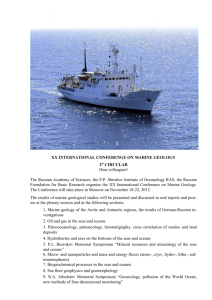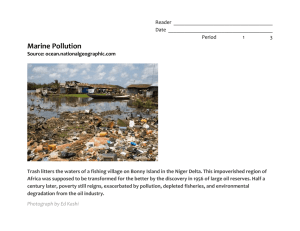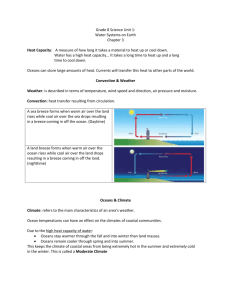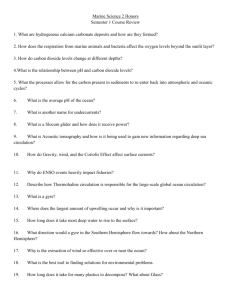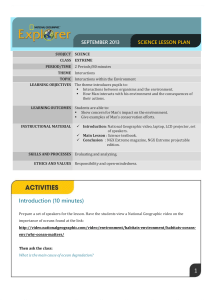Marine science course outline
advertisement
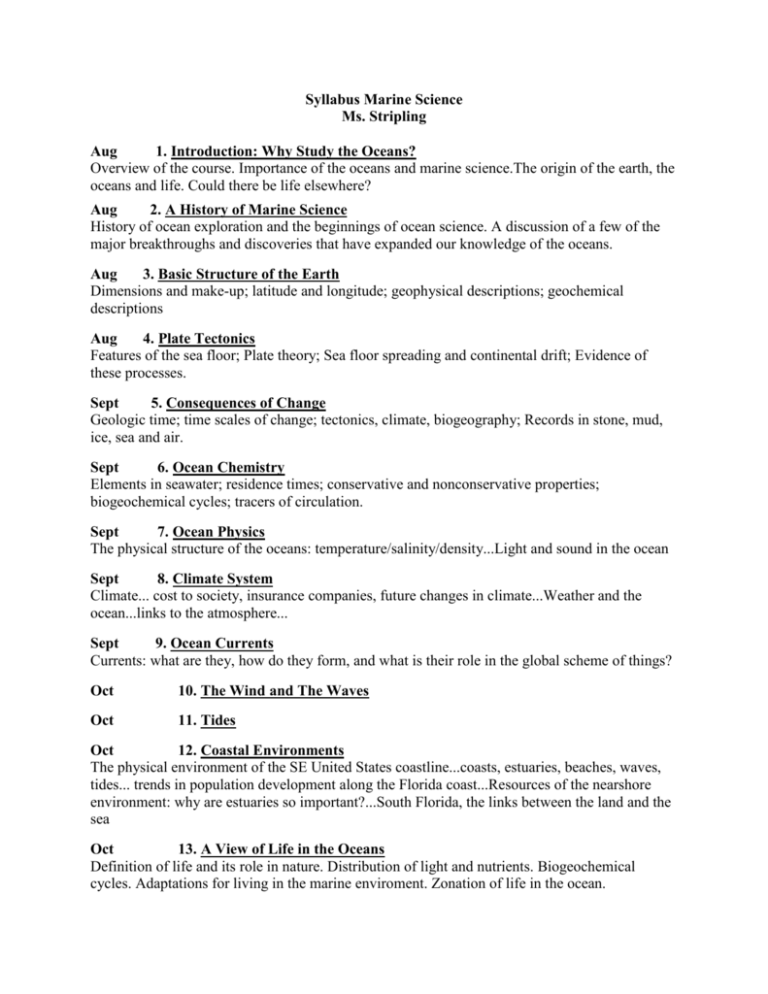
Syllabus Marine Science Ms. Stripling Aug 1. Introduction: Why Study the Oceans? Overview of the course. Importance of the oceans and marine science.The origin of the earth, the oceans and life. Could there be life elsewhere? Aug 2. A History of Marine Science History of ocean exploration and the beginnings of ocean science. A discussion of a few of the major breakthroughs and discoveries that have expanded our knowledge of the oceans. Aug 3. Basic Structure of the Earth Dimensions and make-up; latitude and longitude; geophysical descriptions; geochemical descriptions Aug 4. Plate Tectonics Features of the sea floor; Plate theory; Sea floor spreading and continental drift; Evidence of these processes. Sept 5. Consequences of Change Geologic time; time scales of change; tectonics, climate, biogeography; Records in stone, mud, ice, sea and air. Sept 6. Ocean Chemistry Elements in seawater; residence times; conservative and nonconservative properties; biogeochemical cycles; tracers of circulation. Sept 7. Ocean Physics The physical structure of the oceans: temperature/salinity/density...Light and sound in the ocean Sept 8. Climate System Climate... cost to society, insurance companies, future changes in climate...Weather and the ocean...links to the atmosphere... Sept 9. Ocean Currents Currents: what are they, how do they form, and what is their role in the global scheme of things? Oct 10. The Wind and The Waves Oct 11. Tides Oct 12. Coastal Environments The physical environment of the SE United States coastline...coasts, estuaries, beaches, waves, tides... trends in population development along the Florida coast...Resources of the nearshore environment: why are estuaries so important?...South Florida, the links between the land and the sea Oct 13. A View of Life in the Oceans Definition of life and its role in nature. Distribution of light and nutrients. Biogeochemical cycles. Adaptations for living in the marine enviroment. Zonation of life in the ocean. Oct 14. Marine Ecology Primary productivity of the oceans. Different types of primary producers -- bacteria; diatoms, dinoflagellates, coccolithophores and plants; Measuring primary production. Oct 15. Zooplankton Types of zooplankton; Ways of feeding, vertical migration, bioluminescence, life histories holoplankton vs meroplankton; lifestages. Nov 16. Models of Life in the Plankton Food chains and food webs. Modeling a plankton bloom. Nov 17. Ecosystems in the Sea Oligotrophic central gyres - the ocean deserts; Nutrient-rich subpolar regions; Upwelling regions; Coastal regions; Estuaries. Nov 18. Life on the Sea Floor The benthos - in /on the sediments; Vents, Reefs and Hard Bottoms Nov 19. Coral Reefs Nov 20. Nekton, the free swimmers Fish - variety of forms, some examples: demersal forms (cod), pelagic forms (tuna, swordfish), small pelagics (sardines, anchovies) Nov 21. Marine Mammals and Cod Types of marine mammals; migration patterns, tracking endangered species. Understanding behavior. Dec 22. Oceanic Resources Marine life, food chains, productivity, reliance on the physical and chemical environment... Fisheries, economic values, trends in fish stocks... the future of fisheries...Aquaculture: how is it done?...what is it worth to society?...Whales and marine mammals: their past and future. Dec 23. Marine Pollution Emphasis is on the physical environment, and influence of human population, exploitation. Red Tides and Harmful Algal Blooms


